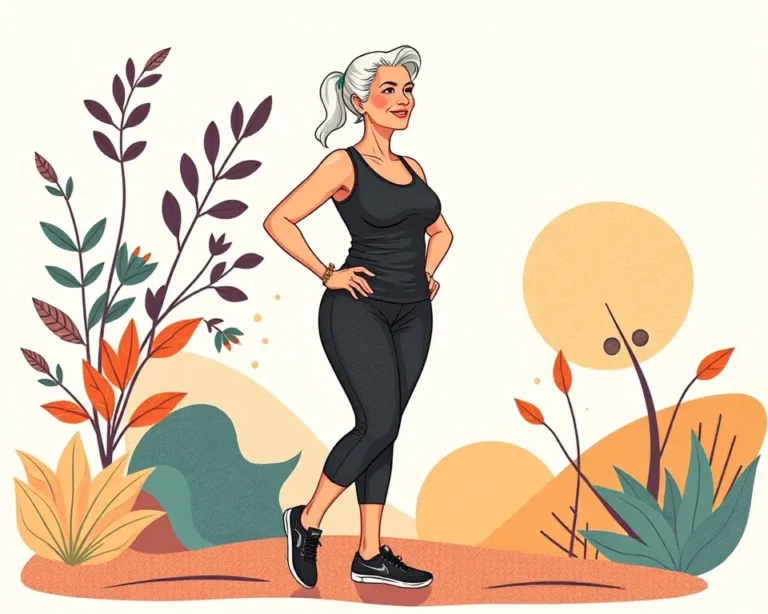Gautami Kapoor, the Indian actress, has been turning heads not just for her acting prowess but also for her radiant fitness at 50. Her approach provides valuable insights for women in their 50s looking to maintain a healthy and active lifestyle. In recent interviews, Gautami has openly shared her fitness and diet secrets, emphasizing the importance of listening to her body and adapting her routine to her needs. This article dives into Gautami Kapoor’s fitness routine, offering actionable advice for women in their 50s looking to embrace a vibrant and healthy life.
Understanding Fitness in Your 50s
Entering your 50s brings unique changes and challenges. Menopause, hormonal shifts, and potential decreases in bone density and muscle mass require a tailored approach to fitness. It’s crucial to shift the focus from extreme diets and intense workouts to sustainable habits that promote long-term health and well-being.
Key Considerations for Women in Their 50s:
- Hormonal Changes: Menopause leads to decreased estrogen levels, impacting bone density, heart health, and metabolism.
- Muscle Mass: Sarcopenia, the age-related loss of muscle mass, can begin in your 40s and accelerate in your 50s, affecting strength and metabolism.
- Bone Density: Estrogen decline increases the risk of osteoporosis, making weight-bearing exercises essential.
- Metabolism: A slower metabolism can lead to weight gain, necessitating a focus on nutrient-dense foods and portion control.
- Joint Health: Joint pain and stiffness can become more common, requiring low-impact exercise options.
- Heart Health: The risk of heart disease increases after menopause, emphasizing the importance of cardiovascular fitness.
Gautami Kapoor’s Holistic Fitness Approach
Gautami Kapoor‘s fitness routine isn’t about quick fixes or extreme measures; it’s a balanced and sustainable approach that integrates exercise, diet, and lifestyle choices.
Exercise: A Blend of Strength, Cardio, and Flexibility
Gautami’s workout regime includes a mix of strength training, Pilates, and cardio, like Zumba or treadmill walking. Her trainer, Sourabh Sanyal, emphasizes the importance of adjusting workouts to suit her body’s needs, particularly during perimenopause.
- Strength Training: Gautami incorporates strength training sessions that target both upper and lower body, focusing on building and maintaining muscle mass and bone density.
- Pilates: Pilates helps build core strength, improve flexibility, and enhance body awareness.
- Cardio: She enjoys Zumba and treadmill walking for cardiovascular health and calorie burning.
- HIIT (High-Intensity Interval Training): Though HIIT is a favorite, Gautami limits it to once a week, recognizing that too much cardio can make her too thin due to her naturally lean physique.
Tailoring Your Workout
Inspired by Gautami Kapoor’s fitness routine, here’s how women in their 50s can create a workout plan that suits their needs:
- Consult a Professional: Talk to your doctor or a certified fitness trainer to assess your current fitness level and identify any physical limitations or health concerns.
- Incorporate Strength Training: Aim for at least two strength training sessions per week. Focus on compound exercises that work multiple muscle groups simultaneously, such as squats, lunges, push-ups, and rows.
- Add Cardio: Include at least 150 minutes of moderate-intensity cardio per week. Choose activities you enjoy, such as walking, jogging, swimming, cycling, or dancing.
- Prioritize Low-Impact Options: If you experience joint pain, opt for low-impact cardio exercises like swimming, cycling, or walking.
- Don’t Forget Flexibility and Balance: Incorporate stretching, yoga, or Pilates into your routine to improve flexibility, balance, and range of motion.
- Listen to Your Body: Pay attention to how your body feels and adjust your workouts accordingly. Don’t push yourself too hard, especially when starting a new exercise program.
- Stay Consistent: Consistency is key to achieving long-term fitness goals. Aim to exercise most days of the week, even if it’s just for a short period.
Sample Workout Routine for Women Over 50
- Monday: Strength Training (Full Body)
- Squats: 3 sets of 10-12 reps
- Push-ups: 3 sets of as many reps as possible (AMRAP)
- Rows: 3 sets of 10-12 reps
- Lunges: 3 sets of 10-12 reps per leg
- Plank: 3 sets, hold for 30-60 seconds
- Tuesday: Cardio (30-45 minutes of brisk walking or cycling)
- Wednesday: Rest or Active Recovery (light stretching or yoga)
- Thursday: Strength Training (Full Body)
- Deadlifts: 1 set of 8-10 reps
- Overhead Press: 3 sets of 10-12 reps
- Pull-ups (assisted if needed): 3 sets of as many reps as possible (AMRAP)
- Step-ups: 3 sets of 10-12 reps per leg
- Crunches: 3 sets of 15-20 reps
- Friday: Cardio (30-45 minutes of swimming or dancing)
- Saturday: Rest or Active Recovery (Pilates)
- Sunday: Long Walk or Hike (60 minutes)
Adaptations for Different Fitness Levels
- Beginner: Start with bodyweight exercises and gradually add weights as you get stronger. Focus on proper form and technique.
- Intermediate: Increase the weight, reps, or sets as you progress. Try more challenging variations of exercises.
- Advanced: Incorporate more advanced exercises, such as plyometrics or Olympic lifts. Consider working with a personal trainer to optimize your routine.
The Importance of Warming Up and Cooling Down
Always begin your workouts with a 5-10 minute warm-up to prepare your muscles for exercise. Include dynamic stretches, such as arm circles, leg swings, and torso twists. End your workouts with a 5-10 minute cool-down to gradually lower your heart rate and prevent muscle soreness. Include static stretches, holding each stretch for 30 seconds.
Diet: Balanced and Nutrient-Rich
Gautami Kapoor follows a disciplined but not restrictive diet. She eats everything in moderation, focusing on fixed meal times and avoiding excessive snacking. She has cut out dairy due to health issues and drinks warm water throughout the day.
Key Dietary Principles for Women in Their 50s:
- Prioritize Protein: Protein is essential for maintaining muscle mass and bone health. Aim for 1 to 2 grams of protein per kilogram of body weight per day. Good sources of protein include lean meats, poultry, fish, eggs, beans, lentils, tofu, and nuts.
- Focus on Fiber: Fiber promotes digestive health, regulates blood sugar levels, and helps you feel full. Aim for at least 21 grams of fiber per day. Good sources of fiber include fruits, vegetables, whole grains, beans, and lentils.
- Embrace Healthy Fats: Healthy fats are essential for hormone production, brain health, and heart health. Choose unsaturated fats, such as those found in avocados, nuts, seeds, olive oil, and fatty fish.
- Load Up on Calcium and Vitamin D: Calcium and vitamin D are crucial for bone health. Aim for 1,200 mg of calcium and 600-800 IU of vitamin D per day. Good sources of calcium include dairy products, leafy green vegetables, tofu, and fortified foods. Good sources of vitamin D include fatty fish, egg yolks, and fortified foods. Sunlight exposure also helps your body produce vitamin D.
- Stay Hydrated: Drink plenty of water throughout the day to stay hydrated and support overall health.
- Limit Processed Foods, Sugar, and Sodium: These foods can contribute to weight gain, inflammation, and other health problems. Choose whole, unprocessed foods as often as possible.
- Be Mindful of Portion Sizes: As metabolism slows down, it’s important to be mindful of portion sizes to avoid weight gain. Use smaller plates and bowls and pay attention to your hunger and fullness cues.
- Consider a Mediterranean Diet: The Mediterranean diet, rich in fruits, vegetables, whole grains, legumes, nuts, seeds, olive oil, and fish, has been shown to have numerous health benefits, including reducing the risk of heart disease, stroke, and cognitive decline.
Gautami Kapoor’s Dietary Habits:
- Fixed Meal Times: She eats her first meal at 11:30 AM and her last meal by 6:30 PM.
- No Snacking: She avoids snacking, except for nuts, seeds, or homemade protein bars.
- No Dairy: She has cut out dairy due to health issues.
- Warm Water: She drinks only warm water throughout the day.
- Black Coffee: She drinks black coffee twice a day.
- Eats Everything in Moderation: She doesn’t restrict herself from enjoying fried food, ghee, or butter.
Adapting Gautami’s Diet for Your Needs
While Gautami’s diet works for her, it’s essential to tailor your dietary choices to your individual needs and preferences. Consider working with a registered dietitian to create a personalized meal plan that meets your specific nutritional requirements.
Lifestyle: Prioritizing Rest and Stress Management
Gautami Kapoor values consistency and a balanced lifestyle. She wakes up early, stays active, avoids afternoon naps, and sleeps by 9:30 PM. She prioritizes spending time at home and avoids excessive socializing.
Key Lifestyle Factors for Women in Their 50s:
- Prioritize Sleep: Aim for 7-8 hours of quality sleep per night. Sleep deprivation can lead to weight gain, mood problems, and impaired cognitive function.
- Manage Stress: Chronic stress can negatively impact your health. Find healthy ways to manage stress, such as exercise, yoga, meditation, or spending time in nature.
- Stay Socially Connected: Social isolation can lead to depression and cognitive decline. Maintain strong social connections with family and friends.
- Engage in Activities You Enjoy: Make time for hobbies and activities you enjoy. This can help reduce stress, improve mood, and enhance overall well-being.
- Limit Alcohol Consumption: Excessive alcohol consumption can increase the risk of various health problems. If you drink alcohol, do so in moderation.
- Quit Smoking: Smoking is harmful to your health and increases the risk of numerous diseases. If you smoke, quitting is one of the best things you can do for your health.
- Regular Check-ups: Schedule regular check-ups with your doctor to monitor your health and screen for potential problems.
Adapting Gautami’s Lifestyle Habits
- Create a Consistent Sleep Schedule: Go to bed and wake up at the same time each day, even on weekends, to regulate your body’s natural sleep-wake cycle.
- Incorporate Stress-Reducing Activities: Find activities that help you relax and de-stress, such as reading, listening to music, spending time with loved ones, or practicing mindfulness.
- Stay Active Throughout the Day: Incorporate physical activity into your daily routine, such as taking the stairs, walking during lunch breaks, or doing household chores.
Common Fitness Mistakes to Avoid in Your 50s
- Overtraining: Pushing yourself too hard can lead to injuries and burnout.
- Following Extreme Diets: Restrictive diets can be unsustainable and may lead to nutrient deficiencies.
- Ignoring Pain: Don’t ignore pain or discomfort. Seek medical attention if you experience persistent pain.
- Comparing Yourself to Others: Everyone’s fitness journey is unique. Focus on your own progress and don’t compare yourself to others.
- Neglecting Mental Health: Mental health is just as important as physical health. Prioritize self-care and seek professional help if needed.
- Not Adjusting Your Routine: As your body changes, you’ll need to adjust your fitness and diet routine to meet your evolving needs.
Embrace the Journey
Gautami Kapoor’s fitness routine offers a valuable blueprint for women in their 50s looking to maintain a healthy and active lifestyle. By focusing on a balanced approach that integrates exercise, diet, and lifestyle choices, women can embrace this new chapter with confidence and vitality. Remember, it’s not about achieving a specific body image but about prioritizing your health and well-being. As Gautami Kapoor wisely says, it’s essential to listen to your body and adjust your routine to meet your individual needs. So, take inspiration from her journey, consult with professionals, and embark on your own path to ageless radiance!







